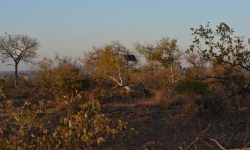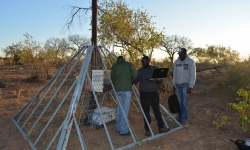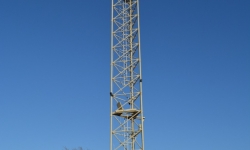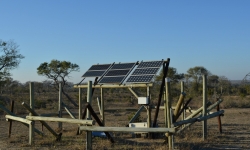Eddy covariance flux towers
The CSIR operates a network of flux towers (the Skukuza, Malopeni and Agincourt flux towers) that is used to measure the amount of gas – such as water vapour and carbon dioxide (CO2) – and energy flux exchanged between the terrestrial ecosystem and atmosphere.
The flux tower sites use the eddy covariance technique to measure these exchanges. Eddy covariance flux systems comprise the open-path infrared gas analyser (LiCor 7500) for measuring CO2 density (or water vapour density) and a three-dimensional (3D) ultrasonic anemometer (Gill Wind Master Pro and Campbell Scientific CSAT3).
The eddy flux towers are integrated with a number of micrometeorological variables, including wind velocity, wind direction, relative humidity, and temperature. The eddy covariance technique provides a method by which the vertical transport of CO2 (or other gases) can be measured by correlating the fluctuations in concentration with fluctuations in vertical wind speed. The eddy covariance technique is one of the most direct and defensible ways to measure such fluxes and this method is mathematically complex, requiring a lot of care when setting up and processing data.
The technique has become a popular tool for evaluating net CO2 (or other gases) exchange from terrestrial ecosystems to the atmosphere and in recent years it has been tested for its potential ability to detect CO2 releases from underground storage reservoirs and in marine environments. Global warming is driven by the build-up of CO2 in the atmosphere and scientists are therefore interested in these measurements for accurate predictions and planning for mitigation.

Technical Specifications
| CO2 | H2O | |
| Calibration Range | 0-3000 ppm | 0-60 ppt |
| Accuracy | Within 1% of reading (nominal) |
Within 1% of reading (nominal) |
| Zero drift (per °C) | ±0.1 ppm typical ±0.3 ppm max. |
±0.03 ppm typical ±0.05 ppm max. |
| RMS Noise: 5 Hz @370 ppm CO2: 10 Hz and 10 mmol m-1 H2O: 20 Hz |
±0.08 ppm ±0.11 ppm ±0.16 ppm |
±0.0034 ppm ±0.0047 ppm ±0.0067 ppm |
| Gain drift (% of reading per °C) | ±0.02% typical ±0.1 % max. @370 ppmv |
±0.15% typical ±0.30% max. @20 ppt |
| Direct sensitivity to H2O (mol CO2/mol H2O) | ±2.00E-05 typical ±4.00E-05 max. |
- - |
| Direct sensitivity to CO2 (mol H2O/mol CO2) | - - |
±0.02 typical ±0.05 max. |
| Parameter | WindMaster Pro |
| Outputs | |
| Output rate | 0.25,0.5.1, 2, 4, 8, 10, 16, 20, 32 Hz |
| Sample rate (automatically selected) | 20 or 32 Hz |
| Units of measure | m/s, mph, KPH, knots, ft/min |
| Format | UVW or Polar |
| Averaging | Flexible 0 - 3600 s |
| Wind Speed | |
| Range | 0 - 65 m/s |
| Resolution | 0.01 or 0.001 m/s |
| Accuracy (12 m/s) (to special order) # | < 1.0 % RMS |
| Accuracy (12 m/s)(Standard)* | < 1.5% RMS |
| ‘w’ improvement multiplication factor | w component only: |
| applied as table, allows comparison to data previously collected with older WindMaster units with firmware 2329-601 or lower without multiplication factor. | +w = 1.166, -w = 1.289 |
| 601 or lower without multiplication factor. | |
| Direction | |
| Range | 0 - 359.9° |
| Resolution | 10 or 0.1° |
| Accuracy (12 m/s) (Standard)* | 2° |
| Accuracy (12 m/s) (to special order)* # | 0.5° |
| Speed of Sound | |
| Range | 300 -370 m/s |
| Resolution | 0.01 m/s |
| Accuracy | < + 0.5% @ 20 °C |
| Sonic temperature | |
| Range | -40 °C to +70 °C |
| Ts' Accuracy (> 1 Hz) (All models, unchanged) | Eddy Covariance Quality |
| Ts Accuracy (slow response, used as ambient thermometer, unit firmware 2329-700 or higher) | + 2°C between -20° C to +30° C |
Research site:
Flux Measurements
- Skukuza (Located in the Kruger National Park near the Skukuza camp, continuous operation since 2000)
- Malopeni (Located in the Kruger National Park near the Phalaborwa gate, operation since 2008)
- Agincourt (high anthropogenic impact sister site to the Skukuza site, Located in rural settlement 30km from the Skukuza tower installed and in operation since June 2016)






